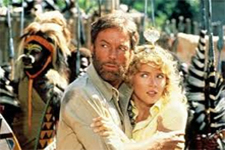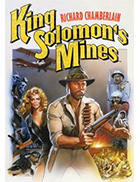King Solomon's Mines
|  When King Solomon’s Mines was released in 1985, everything about it—from the fedora worn by star Richard Chamberlain as adventurer Allan Quartermain, to the font used in the title treatment, to the Drew Struzan-esque movie poster art—suggested that it was little more than a opportunistic rip-off of Steven Spielberg and George Lucas’s Indiana Jones series, which at the time included Raiders of the Lost Ark (1981) and Indiana Jones and the Temple of Doom (1984). And, watching the film, you can’t help but feel the influence of that series everywhere, especially when Quartermain is being dragged behind a train just like Indy was dragged behind a truck in Raiders, when the spiked ceiling of a trip-wire cavern starts closing in on the heroes just as it did in Temple of Doom, and pretty much any time Quartermain finds himself in over his head and offers an exasperated quip to try to ease the tension. Unfortunately, Chamberlain, a good actor when in the right material, is no Harrison Ford, and director J. Lee Thompson, in the twilight of his long career, is no Steven Spielberg. The irony, of course, is that the character of Allan Quartermain long predates Indiana Jones. He was introduced in H. Rider Haggard genre-defining African adventure novel King Solomon’s Mines in 1885, which was then adapted to the screen in 1937 and 1950. More than that, Quartermain was actually one of the numerous characters that Lucas used as inspiration when he created his own swashbuckling adventurer (others models included Alan Ladd’s war profiteer in 1943’s China, Humphrey Bogart’s gold prospector in 1948’s The Treasure of the Sierra Madre, and Charlton Heston’s fortune hunter in 1954’s The Secret of the Incas). Arguably none of those characters, nor the exotic foreign adventures in which they embark, would exist without Haggard’s novel, which single-handedly created the “Lost World” literary genre that would inspire the imaginations of Edgar Rice Burroughs, Sir Arthur Conan Doyle, and Rudyard Kipling. It’s a shame, then, that this third screen version of King Solomon’s Mines turned out to be such a lousy movie, as its reliance on modern conventions and its unabashed aping of the Indiana Jones franchise effectively erased its source material’s long and fascinating literary and cultural history, making it appear to be nothing more than a cheap knock-off, rather than an adaptation of a much beloved novel. The film is set entirely in Africa, and we are introduced to Quartermain as he is hacking through the jungle with his porter, a hulking African named Umbopo (Ken Gampu), and Jesse Huston (Sharon Stone), the plucky daughter of an archaeologist who we saw abducted in the film’s pre-credit sequence by the story’s villains, the German colonel Bockner (Herbert Lom) and the Turkish mercenary Dogati (John Rhys-Davies, who played the lovable Sallah in Raiders), because he is able to decipher a map leading to the film’s titular treasure storehouse. With the exception of Quartermain, all of those characters are the creation of screenwriters Gene Quintano and James R. Silke, who clearly felt the imperative to follow the formula set by the previous screen version by giving Quartermain a female partner and love interest and to use what worked in Raiders by making a German (albeit of the World War I variety) the primary villain. These new characters are only part of the film’s problem, but they are a substantial component of its bizarre tonal imbalance. Stone, would go on to major success in the 1990s following her notorious turn as an icy, bisexual femme fatale in Paul Verhoeven’s Basic Instinct (1992), plays Jesse as a silly, often panic-stricken comic foil, who spends most of the film clinging to Quartermain, cowering behind him, or weeping about her imminent demise. She plays tough a few times, but it feels forced; her primary characteristic is wild-eyed hysteria (she was obviously modeled more on Kate Capshaw’s Willie in Temple of Doom than Karen Allen’s Marion in Raiders). Herbert Lom and John Rhys-Davies’s villains are no better, as they are cast primary as comical buffoons, which renders them impotent in terms of menace. Lom seems to think he’s still in one of Blake Edwards’s Pink Panther movies, while Rhys-Davies glowers and growls like the “Bad Arab” he’s expected to be, but to little effect (he does get to complain quite a bit about Lom’s constant playing of Wagner, though). The film was produced by Cannon Films under the aegis of mega-producers Menahem Golan and Yoram Globus, who flooded the market in the 1980s with low-budget, slapdash action, adventure, science fiction, comedy, and horror films. The ubiquitous Cannon logo and the Golan-Globus imprimatur became synonymous with a particular kind of movie that had little in the way of ambition, but promised something entertaining, if often badly so. And they were nothing if not prolific; King Solomon’s Mines was but one of 23 films they produced in 1985 alone, a list that includes the Chuck Norris vehicles Missing in Action 2: The Beginning and Invasion U.S.A., the third of Charles Bronson’s Death Wish series, the crass teen comedy Hot Resort, and the relatively prestigious action drama Runaway Train, a project that had been developed for years by Akira Kurosawa. King Solomon’s Mines, with its South African locales, cast of hundreds, and big set pieces that include a massive cauldron rolling down a hill, a fight on a speeding train, and the titular mines with their various explosive booby traps, a spider the size of a Volkswagen, and a massive underwater creature of some kind, was clearly one of their bigger productions. Yet, everything feels like it was done on the cheap. Doors supposedly made of solid stone shimmy weightlessly when they close, big explosions are often accomplished with optical effects rather than actual destruction, the badly matted blue-screen effects used to put the stars in harm’s way undercut any sense of actual danger—and let’s not even talk about how chintzy that spider looks. Chamberlain and the rest of the cast ham their way through the proceedings, perhaps trying to distract us from how ineffective a lot of it is with self-deprecating comments like “They’ve thought of everything” and Jesse telling Quartermain that the only one who thinks his jokes are funny is him. The entire enterprise has a deliberate tongue-in-cheek feel, but it’s primarily defensive—a calculated protection against criticism because, after all, it’s just a big joke (I can imagine it also being intended to inoculate the film against charges of racism, considering how often the screen is filled with spear-wielding black bodies yelling in threatening African dialects before either trying to boil the white heroes alive—“Maybe they like white meat,” Quartermain quips—or feed them to snapping crocodiles). Director J. Lee Thompson had helmed some rough, gritty classics in his heyday (including 1961’s The Guns of the Navarone and 1962’s Cape Fear), but by the mid-1980s had settled down into a series of generally forgettable low-budget actions films, most of which were made for Cannon (four of his final five films, made in the years after King Solomon’s Mines, starred Charles Bronson). His direction here is generally capable, although at times pedestrian to the point of being lackluster. It all adds to up to a largely unimaginative adventure, albeit not one that isn’t entirely without its entertaining qualities, even if said qualities are best appreciated with a heavy dose of irony.
Copyright © 2017 James Kendrick Thoughts? E-mail James Kendrick All images copyright © Olive Films | |||||||||||||||||||||||||||||||||||
Overall Rating: 
 (2)
(2)


